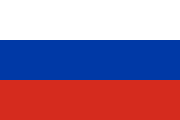
Back Wit beweging Afrikaans الحركة البيضاء Arabic Ağ ordu Azerbaijani Аҡтар хәрәкәте Bashkir Белы рух Byelorussian Бяло движение Bulgarian Bílé hnutí Czech Den Hvide bevægelse Danish Weiße Bewegung German Λευκός Στρατός Greek
The White movement (Russian: pre–1918 Бѣлое движеніе / post–1918 Белое движение, tr. Beloye dvizheniye, IPA: [ˈbʲɛləɪ dvʲɪˈʐenʲɪɪ]),[a] also known as the Whites (Бѣлые / Белые, Beliye), was a loose confederation of anti-communist forces that fought the communist Bolsheviks, also known as the Reds, in the Russian Civil War (1917–1923) and that to a lesser extent continued operating as militarized associations of rebels both outside and within Russian borders in Siberia until roughly World War II (1939–1945). The movement's military arm was the White Army (Бѣлая армія / Белая армия, Belaya armiya), also known as the White Guard (Бѣлая гвардія / Белая гвардия, Belaya gvardiya) or White Guardsmen (Бѣлогвардейцы / Белогвардейцы, Belogvardeytsi).
During the Russian Civil War, the White movement functioned as a big-tent political movement representing an array of political opinions in Russia united in their opposition to the Bolsheviks—from the republican-minded liberals and Kerenskyite social democrats on the left through monarchists and supporters of a united multinational Russia to the ultra-nationalist Black Hundreds on the right.
Following the military defeat of the Whites, remnants and continuations of the movement remained in several organizations, some of which only had narrow support, enduring within the wider White émigré overseas community until after the fall of the European communist states in the Eastern European Revolutions of 1989 and the subsequent dissolution of the Soviet Union in 1990–1991. This community-in-exile of anti-communists often divided into liberal and the more conservative segments, with some still hoping for the restoration of the Romanov dynasty.
- ^ Joana Breidenbach (2005). Pál Nyíri, Joana Breidenbach (ed.). China inside out: contemporary Chinese nationalism and transnationalism (illustrated ed.). Central European University Press. p. 90. ISBN 978-963-7326-14-1. Retrieved 18 March 2012.
Then there occurred another story which has become traumatic, this one for the Russian nationalist psyche. At the end of the year 1918, after the Russian Revolution, the Chinese merchants in the Russian Far East demanded the Chinese government to send troops for their protection, and Chinese troops were sent to Vladivostok to protect the Chinese community: about 1600 soldiers and 700 support personnel.
- ^ "The Tragedy of Albania's Russian Community". Russkiy Mir Foundation. 19 September 2008. Archived from the original on 12 July 2018. Retrieved 12 July 2018.
- ^ Sven Anders Hedin, Folke Bergman (1944). History of the expedition in Asia, 1927–1935, Part 3. Stockholm: Göteborg, Elanders boktryckeri aktiebolag. pp. 113–115. Retrieved 2010-11-28.
- ^ Great Britain. Foreign Office (1997). British documents on foreign affairs – reports and papers from the Foreign Office confidential print: From 1940 through 1945. Asia, Part 3. University Publications of America. p. 401. ISBN 1-55655-674-8. Retrieved 28 October 2010.
Cite error: There are <ref group=lower-alpha> tags or {{efn}} templates on this page, but the references will not show without a {{reflist|group=lower-alpha}} template or {{notelist}} template (see the help page).
© MMXXIII Rich X Search. We shall prevail. All rights reserved. Rich X Search
